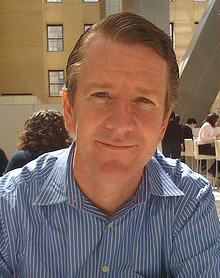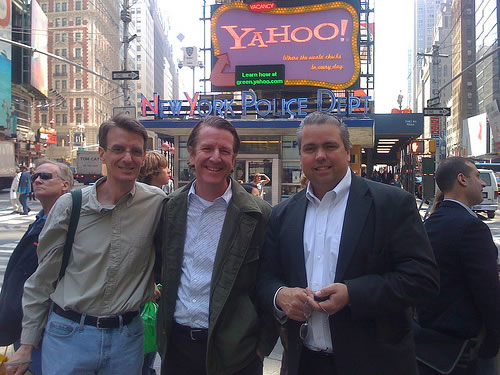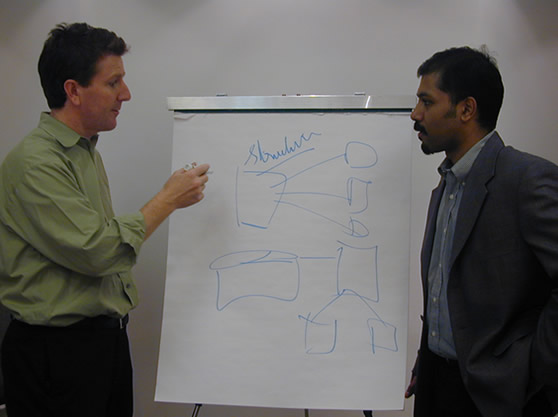
- Learn How A Leading NYC CTO Went From Being An Isolated Tech Introvert To Managing 100+ People
- Find Out How To Qualify For The Private Invite-Only NYC CTO Club
- Discover How Jon Williams (ex CTO iVilliage) Stays Current With Technology
Full Interview Audio and Transcript
Personal Info
Hobbies and Interests: Acoustic Guitar, Stand Up Paddle Surfing (SUP), Tennis.
Sports teams: St Kilda FC (Australian Rules Football), Australian Cricket team.
Favourite Books:
- Collapse: How Societies Choose to Fail or Succeed by Jared Diamond
- A Short History of Nearly Everything by Bill Bryson
- Harry Potter: Books 1 through 7 by JK Rowling
Favourite Entrepreneurs: Larry Page & Sergey Brin, Jeff Bezos.
Personal blog: http://newyorkcto.blogspot.com
Fast Track Interview
Adrian Bye: I’m talking with Jon Williams, who is an Australian living in New York. He actually left Australia only a couple of years before I did. He runs a pretty low-profile organization called the New York CTO Club, which is a collection of the top CTOs in New York City. Jon has also been a CTO in a number of well-known internet organizations. Jon, thanks for joining us. Can you tell us a little bit about where you grew up in Australia?
 Jon Williams: Sure. I grew up in Melbourne, Australia. I went to Melbourne High School and Melbourne University. My first technology job was as a C programmer in the 80s. Actually, I was the number 11 employee at a startup company called Cyber Graphics that made computer systems for newspapers.
Jon Williams: Sure. I grew up in Melbourne, Australia. I went to Melbourne High School and Melbourne University. My first technology job was as a C programmer in the 80s. Actually, I was the number 11 employee at a startup company called Cyber Graphics that made computer systems for newspapers.
Adrian Bye: What made you move to the States?
Jon Williams: We were always looking for operating systems, compilers and other tools to help us build software. All of the vendors I was using were based in the US. I came over on a business trip in 1984, and I actually had my first visit to Disneyland. It might sound odd, but it was a dream.
Then I went to the real technology Disneyland, which is Silicon Valley. I spent three days in Silicon Valley talking to a bunch of vendors and said to myself, “My goodness, I was born in the wrong country. This is my dream to work with all of these companies.” I got more done in those three days in Silicon Valley than I had spent in a year trying to research tools in Australia. Again this was before the internet.
I went back to Australia, and then a couple of years later, my boss said, “We’re opening an office in the United States. Would you like to go?” I said, “Yes,” in two minutes. I only knew that I was moving to a place called Manchester, New Hampshire. I spent two years in New Hampshire and two years in Boston. Then by 1990, I finally found my way to New York.
Adrian Bye: How did you decide to become a CTO?
Jon Williams: At first, I didn’t decide to become a technology manager. I was actually promoted a few times and demoted. I was a really bad manager. In fact, in the beginning of my management career, I was a lead developer with no people skills. One day I woke up and figured, “I don’t have any people skills. I better do something about that.”
I had some great managers and mentors, and I started to learn from them how to manage people and teams. At that time, I was working seven days a week, and I could only get a finite amount of stuff done. When I started leading teams though, I could get a lot more done. That was my motivation to become a CTO.
Adrian Bye: You don’t just get people skills overnight. How did you learn to lead those teams?
 Jon Williams: I had a patient boss who worked with me on how to deal with staff. I also went to some communication courses. I actually went to one communication course that had a segment about nonverbal communication. As a technologist with a scientific background I thought, “Well, that’s insane. There’s no such thing.” Then I realized that there’s empathy, facial expressions, posture and other things that are really important elements in communication. I also realized I didn’t have good sensitivity skills to what my technology teams were thinking and feeling, so I started asking them what they thought and what they felt. That was really the buildup towards becoming an effective manager.
Jon Williams: I had a patient boss who worked with me on how to deal with staff. I also went to some communication courses. I actually went to one communication course that had a segment about nonverbal communication. As a technologist with a scientific background I thought, “Well, that’s insane. There’s no such thing.” Then I realized that there’s empathy, facial expressions, posture and other things that are really important elements in communication. I also realized I didn’t have good sensitivity skills to what my technology teams were thinking and feeling, so I started asking them what they thought and what they felt. That was really the buildup towards becoming an effective manager.
Adrian Bye: How long did it take you to become a good manager?
Jon Williams: That’s quite a bit embarrassing. It probably took five years to go from bad to okay, and then I’ve been refining those management skills ever since.
Adrian Bye: How big are the teams you’ve managed?
Jon Williams: I started with a team of 15 developers. Then I went right up to close to teams of 100 people. That’s where I’m really managing people who are managing people, and it’s a whole different thing.
Adrian Bye: You said you started to ask your teams what they thought or felt. What if they don’t tell you at all or don’t even tell you the truth?
Jon Williams: You can only go by what they say. First of all, the relationships are based on trust. You have to believe what they say, but you take a point of view about it. In a particular conversation, you may say, “That doesn’t sound right,” or “it’s not making sense to me.” There are safe ways to tell people you don’t believe them. You could also make it objective and say, “That’s hard to believe” instead of making it personal. The other tool is really not just communicating one-on-one with them but helping them communicate with each other. Then you’re getting other sources of information about your teams. It’s important to hear backchannel what’s going on with your teams as much as it is to hear from someone directly.
Adrian Bye: How do you get that through the backchannel?
Jon Williams: You get it from other team members. As long as you’re creating trustful relationships and not betraying confidences or playing people off of each other, you’ll find that everyone has a focus on working together and getting things done right. As a result, they’ll be happy to communicate with you when they hear about other people’s concerns. I find people are more than happy to pass along when someone is not happy or they have concerns. You then just have to be an open door and make it okay for people to pass that along to you.
Adrian Bye: Interesting. What other courses or materials did you study to develop this? For a lot of guys who run companies, it’s an area that’s fairly easy for them. It’s interesting that it wasn’t easy for you but that you actually had to learn it.
Jon Williams: Yes. I have an opinion that technologists are typically not good at this. It seems the people who are good at programming computers and being very focused on a single task in technology and all of that abstraction outside the real world seem to not be the best managers.
The starting point for me was realizing that I wasn’t a good manager and that there were people to learn from. It was really realizing that management in itself is a discipline. That was really the breakthrough for me. Up until that point, I thought people did management just naturally. Then I realized that management is a discipline you need to learn and there are techniques, approaches and models to doing it.
 Adrian Bye: Interesting. Tell us a bit about CTO Club.
Adrian Bye: Interesting. Tell us a bit about CTO Club.
Jon Williams: When I was consulting and working with other CTOs, most of these people didn’t know each other. They were effectively islands in New York City. I’ve done a lot of work in Silicon Valley and all my friends there have people they worked with at Oracle, Sun, Apple and all the other technology companies in California. When they got stuck on a gnarly technology problem, they just call someone up and get advice. In New York, that just wasn’t the case.
I was working with Igor Shindel at Time Warner, and he and I decided to start the New York CTO Club. We got 15 CTOs in a room over breakfast and just started discussing technology. At that time, it was viewed as a competitive advantage not to share what technologies you were using outside of the four walls of your company. We were basically all told to be secretive about technology. With open source today, that’s the complete opposite to what we all do. We’re all telling everyone what technology we use.
We were a little cautious at first, but at the fifth meeting, I had that head-exploding moment. I found three other CTOs had experience with a vendor I was actually in negotiations with. Here I am talking to three people that had already licensed the product I wanted to use, and they were giving me the real-world case of what worked, what didn’t work and how to work with this vendor.
That was the breakthrough moment for me. I now had information I could reflect back to the vendor to hold them truthful to their product and contracts that I didn’t have prior to that. I was then able to sit down with the vendor and say, “I’m really worried about x, y and z” even though that was not information the vendor had given me.
Adrian Bye: Who’s in the CTO Club?
Jon Williams: We have members from AIG, Barnes and Noble, Cablevision, McGraw-Hill, banks like JP Morgan, Bank of America. We have members from a couple of museums. These aren’t just CTOs. These are people who have some type of technology-management role. Certainly if I had someone from Morgan Stanley, I don’t have the number one technologist there. I’ll have someone that’s managing a team between 10 and 100 people and a technology budget between $2 million to $100 million.
We’re a private nonprofit group, and it’s invitation only. You really need to be introduced via another member to become part of the club. We’re not a group that’s trying to expand or to do anything more with our group. It’s really something that individual members benefit from, and there’s a trust and camaraderie between a small, trusted group that you don’t get when you make it into a bigger group.
Our members also have to be New York City-based and regularly attend our monthly meetings. We’ve had a number of people who wanted to join but didn’t want to come to our monthly face-to-face meetings. They wanted to be virtual, and that’s not the type of member we’re looking for. You don’t have to come to every meeting, but you don’t want to miss too many in a row. These face-to-face meetings are where we build the trust within the group.
Adrian Bye: How big is the CTO Club?
Jon Williams: It’s about 80-plus members.
Adrian Bye: What actually goes on at your meetings?
Jon Williams: Our meetings start at 7:30 AM. We’re done at 9:30 AM. From 7:30 to 8:30, we’re catching up each other on projects and just general networking. Then from 8:30 to 9:30, we have a different speaker every month. Sometimes it’s a club member. About a third of the time, we have external speakers. We’ve had speakers like Fred Wilson from Union Square Ventures. We’ve had Jeremy Allaire who invented ColdFusion.
Our meetings are highly interactive, and we don’t allow PowerPoint. When I prep a speaker for the meeting, I say, “You will be interrupted frequently and often. You need to go with that. Please prepare a loose agenda and be ready to go where the questions are.”
 We don’t want to hear the fluffy, glossy stuff. We want to hear the real story. We want to hear what really happened. What was the issue and how was it dealt with? Since it’s a safe environment, people are comfortable having those real-world discussions. Their boss isn’t in the room, so it’s okay for them to talk about what they were challenged with, what didn’t work and how they dealt with it.
We don’t want to hear the fluffy, glossy stuff. We want to hear the real story. We want to hear what really happened. What was the issue and how was it dealt with? Since it’s a safe environment, people are comfortable having those real-world discussions. Their boss isn’t in the room, so it’s okay for them to talk about what they were challenged with, what didn’t work and how they dealt with it.
We also really promote and encourage members to connect separate from the club, such as having lunch and breakfast. The other area that comes up is in hiring. We want to be cognizant of not poaching each other’s technology team and handling that in a delicate and professional manner.
I do have to say that the CTO Club is just one of many networking organizations. Networking has an extremely high value for technologists. Every time I talk to a new technologist about a technology, I am in constant learning mode, and technologists love to learn.
There’re so many amazing networking places and opportunities in New York. The New York Tech Meetup is one of those. Start scanning technology groups in meetup.com for different opportunities to network. SIM in New York and the tri-state areas is other technology networking group open to all. Every team that I’ve ran, I’ve always encouraged networking as much as possible.
Adrian Bye: Yes, because it adds a lot of value. How would you suggest a business guy who is making a startup find a CTO-type cofounder? What works?
Jon Williams: It’s usually been through a personal connection. The model that works best is to find someone you worked with in the past. That’s the absolute best model because you know what you’re getting; you know the relationship. If you’re a startup CEO or executive, find someone that either you’ve worked with in the past or someone you trust has worked with in the past. If that’s not available to you, go to these networking events, meet as many CTOs as possible and find the one that’s right for you.
Another model that I’ve seen work well involves a CEO having a seasoned CTO or technologist advising them and helping them select a young CTO. That’s a great model because you can basically grab any technologist you know from any company, buy them breakfast, lunch or dinner, e-mail them and pick their brain. While they’re getting paid in their day job, you can get them to advise you on how to approach technology if you’re a new startup.
Adrian Bye: What you’re saying is that you can effectively take sharp tech guys and turn them into CTOs?
Jon Williams: Yes. A seasoned CTO has the network and knows when and how to ask for help. Whereas the young, sharp guy who’s becoming a CTO thinks the only thing he has in his toolkit is solving every problem himself.
When you see companies running into scaling issues, you need to ask if they have talked to five other people who’ve had these problems before. In almost every technology case, someone else has had this same problem before you, so go and talk to them.
When I’m advising a young CTO in a startup, I’ll say, “Tell me the problem. Oh! Go talk to so and so,” “Go research that,” or “Let me make an introduction here.” Technologists find that when they help others, they’re almost always getting something in return. That’s not the motivation for it. This is something CEOs do really well, and CTOs kind of lag in realizing that this is a valuable job skill.









